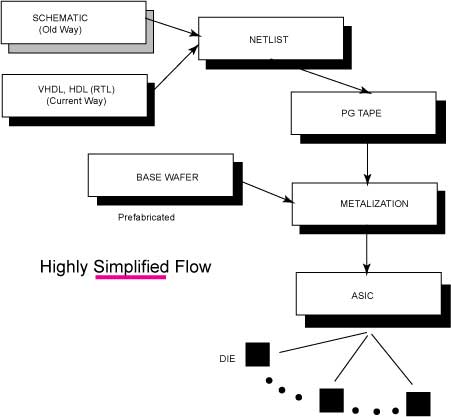Logic Design for Array-Based Circuits
by Donnamaie E. White
- Table of Contents
- Preface
- Overview
- Chapter 1 Introduction
- Chapter 2 Structured Design Methodology
- Chapter 3 Sizing the Design
- Chapter 3 Appendix = Case Study in Sizing a Design
- Chapter 4 Design Optimization
- Chapter 5 Timing Analysis for Arrays
- Chapter 6 External Set-up and Hold Times
- Chapter 7 Power Considerations
- Case Study: DC Power Computation
- Case Study: AC Power Computation
- Chapter 8 Simulation
- Case Study: Simulation
- Chapter 9 Faults and Fault Detection
- Chapter 10 Design Submission
- ASIC Glossary
Introduction
Introduction to Chapter 1
Application-Specific Integrated Circuits (ASIC) [1996]
Application-specific integrated circuits (ASICs) fit between the detailed full-custom circuit designs and the off-the-shelf pre-designed components. They offer the designer a faster method of tailoring the circuit to the task while retaining most of the fast design turn-around time offered by predesigned parts.
The Array
An ASIC array is a single die from a production wafer. in the 1990s, it was generally two or three layers of metalization placed on top of a base array. Figure 1-1 provides an overview of the steps involved in building a semi-custom array.
By 2001, the levels of metalization had climbed to an average of six layers of metalization. At least two layers are usually reserved for power-ground planes. The layers in the base array varied with the process with 26-28 layers in the base die being a reasonable assumption.
Figure 1-1 Semicustom Array Processing

The base array is predesigned by the array vendor. It consists of the layers required to define the cells and the components within them. These components vary depending on the type of cell and the array family. They are resistors, diodes, transistors (bipolar or CMOS) with capacitance and impendance implied in the layering. The threshold voltage generators and other overhead circuitry will also be included in the base design.
WAFER ----------------->
DIE
multiple die
Individual array
| WAFER -----------------> | DIE |
| multiple die | Individual array |
The array designer will have already determined where the fixed power and ground pads are located, how many types and how many of each type of cell there is per array, and what design rules are required in the use of the array. The base array is pre-manufactured, reducing the turn-around time of the design between design acceptance and prototype or production.
CBA Design System designers had the privilege of designing their own base die, including punch-outs for hard IP blocks, and power-ground routing for RAMs and soft IPs.
The wafer is put through wafer-sort to determine good and bad die. The die is a pre-packaged part which can be and is tested. When packaging is completed, the packaged part is retested.
Wafer verification software (Dracula comes to mind) must verify all layers of the wafer, metalization and the base die, and verify that all IP blocks and memory blocks are properly connected. Hard IP blocks interconnect or "stitch" into all levels of the base die.
Customization
The customization of the array comes from the interconnect of the base array components. The interconnect is both the intraconnect between components within a cell to form a function, called a macro, and the interconnect between the macros to form the circuit module. One or more modules may be placed on an array.
The interconnect between macros is considered the routing or nets. Routability is a measure of the ability to transform the design to physical metal etch patterns or the metalization of the array. The macros are formed by a predefined layout pattern that is not considered part of the routing problem.
Macros may exist with several "footprints", which allow them to be positioned with different layout aspects. They also exist in different drive versions, which may also cause differences in the layout pattern. Switching a macro from one drive configuration to another may require its relocation in the circuit layout.
With the high-speed arrays already available, the time delay or propagation delay through an interconnect net under heavy loading conditions may exceed the propagation delay through a macro. Priority pre-placement, design optimization for speed and other design approaches must be used to control the interconnect delays.
For DSM technologies, any technology below 0.18 micron, it is given that the interconnect delays will represent approximately 70% or more of the timing path delay |
These technologies require pro-active design methodologies to be successful. Design partitioning, placement, and careful constraints are all required for a successful DSM design.
Copyright © 1996, 2001, 2002, 2008 Donnamaie E. White , WhitePubs
Enterprises, Inc.
For problems or questions on these pages, contact [email protected]